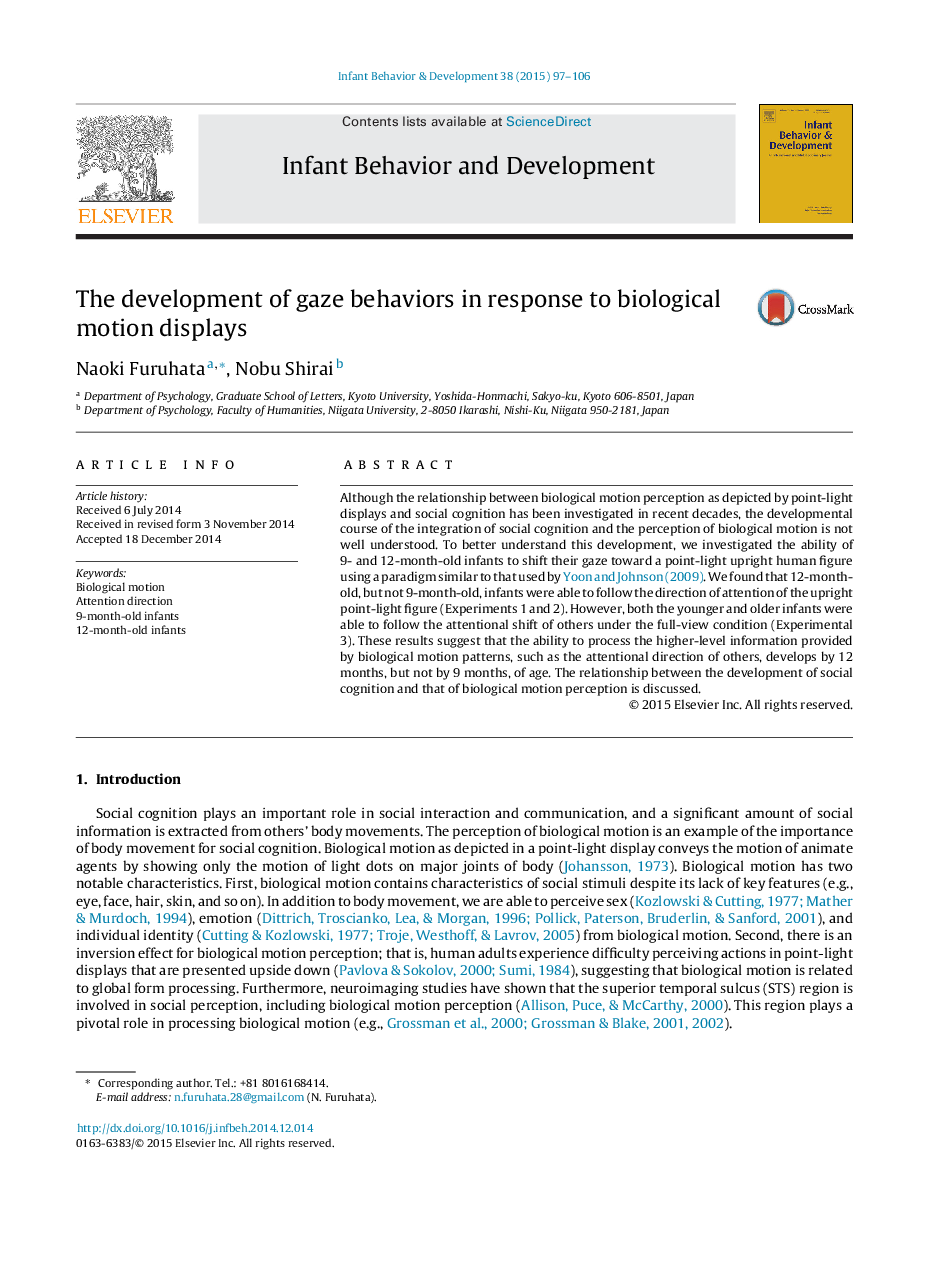| کد مقاله | کد نشریه | سال انتشار | مقاله انگلیسی | نسخه تمام متن |
|---|---|---|---|---|
| 7273457 | 1473422 | 2015 | 10 صفحه PDF | دانلود رایگان |
عنوان انگلیسی مقاله ISI
The development of gaze behaviors in response to biological motion displays
ترجمه فارسی عنوان
توسعه رفتارهای دید در پاسخ به حرکت بیولوژیکی نمایش داده می شود
دانلود مقاله + سفارش ترجمه
دانلود مقاله ISI انگلیسی
رایگان برای ایرانیان
کلمات کلیدی
حرکت بیولوژیکی، جهت توجه، نوزادان 9 ماهه، نوزادان 12 ماهه،
ترجمه چکیده
گرچه رابطه بین ادراک حرکت بیولوژیکی با نمایش های نور نقطه ای و شناخت اجتماعی در دهه های اخیر مورد بررسی قرار گرفته است، روند توسعه ادغام شناخت اجتماعی و درک حرکت بیولوژیکی به خوبی درک نشده است. برای درک بهتر این پیشرفت، توانایی بچه های 9 و 12 ماهه را برای جلب توجه خود به یک چهره انسان راست قائلیه با استفاده از یک پارادایم شبیه یون و جانسون (2009) مورد بررسی قرار دادیم. ما متوجه شدیم که نوزادان 12 ماهه اما نه ماهه 9 ساله توانستند جهت توجهی از شکل نقطه راست نور (آزمایشات 1 و 2) را دنبال کنند. با این حال، هر دو نوزاد جوان و بزرگتر قادر به پیگیری توجه توجه دیگران تحت شرایط کامل مشاهده (تجربی 3). این نتایج نشان می دهد که توانایی پردازش اطلاعات سطح بالای ارائه شده از سوی الگوهای حرکت بیولوژیکی، نظیر جهت گیری توجه دیگران، به مدت 12 ماه، اما نه به 9 ماه، پیشرفت می کند. رابطه بین توسعه شناخت اجتماعی و شناخت حرکت حرکتی بحث شده است.
موضوعات مرتبط
علوم زیستی و بیوفناوری
علم عصب شناسی
علوم اعصاب رفتاری
چکیده انگلیسی
Although the relationship between biological motion perception as depicted by point-light displays and social cognition has been investigated in recent decades, the developmental course of the integration of social cognition and the perception of biological motion is not well understood. To better understand this development, we investigated the ability of 9- and 12-month-old infants to shift their gaze toward a point-light upright human figure using a paradigm similar to that used by Yoon and Johnson (2009). We found that 12-month-old, but not 9-month-old, infants were able to follow the direction of attention of the upright point-light figure (Experiments 1 and 2). However, both the younger and older infants were able to follow the attentional shift of others under the full-view condition (Experimental 3). These results suggest that the ability to process the higher-level information provided by biological motion patterns, such as the attentional direction of others, develops by 12 months, but not by 9 months, of age. The relationship between the development of social cognition and that of biological motion perception is discussed.
ناشر
Database: Elsevier - ScienceDirect (ساینس دایرکت)
Journal: Infant Behavior and Development - Volume 38, February 2015, Pages 97-106
Journal: Infant Behavior and Development - Volume 38, February 2015, Pages 97-106
نویسندگان
Naoki Furuhata, Nobu Shirai,
